FUNERAL SERVICES
“We belong to Allah and to Him we shall return.”
The Prophet said, “How wonderful is the case of a believer; there is good for him in everything and this applies only to a believer. If prosperity attends him, he expresses gratitude to Allah and that is good for him; and if adversity befalls him, he endures it patiently and that is better for him”.
One of the most challenging moments in life is to bid farewell to someone we love or care for. As a Muslim, we must trust Allah’s (S.W.T.) will and to pray for the mercy and forgiveness of the deceased. The Board of the Rahmah Center would like offer our condolences during this difficult time and allow you some time to grief in our masjid. Before continuing, there is proper protocol and guidelines the board of directors must follow to ensure regulations regarding the pandemic are being followed for the safety of all. We kindly ask all applicants to fill and send in the program request proposal. “To Allah we belong and to Him we shall return.” [2:156]
Please contact Najah Al-Haj at (403) 615-9994 for all funeral services and processing.
For funerals: please contact the MCC Coordinator at (587) 438-1731
Booking Funeral Request Form
How to wash the deceased in Islam?
When a Muslim dies, it is the responsibility of his family or other Muslims within the local community to wash him according to the Islamic rites of washing the deceased. Usually, three to four people will be involved with the actual ghusl (washing and shrouding).
The persons who may wash the deceased should:
- Be an adult Muslim, honest and trustworthy person
- Be of the same gender as the dead. For example, if the deceased is male, then ONLY males should wash him.
- For a child, either males or females may do the ghusl
- Know the Islamic way of washing the deceased and be able to carry out the ghusl
- It is recommended that those who performed the washing should make wudhu (ablution)
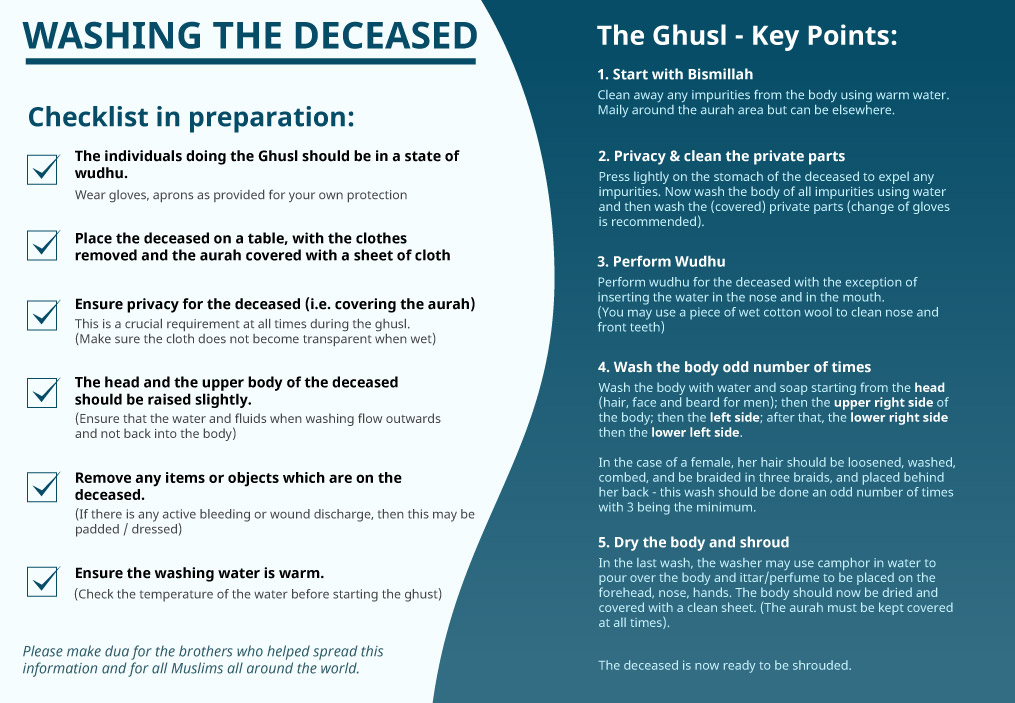
Place of washing:
- The deceased’s body should be washed in a clean, secluded, private place where clean water and soap are available. Gloves must always be worn when handling and washing the deceased.
- The deceased’s body should be washed with water and, if available, lotus leaves or camphor (to be used in the final wash).
- The washing steps should be done at least three times the anymore odd number of times as necessary to cleanse.
- Always be mindful of infection control and protecting the person performing the Ghusl.
- Our Ghusl facility provides disposable gloves, aprons, and face masks—bins for general rubbish as well as Hazardous waste bins for any contaminated waste removed from the body. Only use the hazardous bins for toxic waste as there is an additional fee incurred to dispose of this separately.
Steps of washing:
Privacy for the deceased is a crucial requirement at all times during the ghusl.
- The body of the deceased should be placed on a table, the deceased’s clothes should be removed, and the body should be covered with a sheet of cloth at all times during the ghusl.
- The Auwra (private parts) of the deceased should be covered with a sheet of cloth. The aura of a male is from the belly button to the knee in the presence of males, for the female is the same in the presence of females.
- The head and the upper body should be raised slightly to ensure the washing water with exudations from the body flows down and does not run back to the body.
- Remove any items or objects not already removed. These include watches, hospital or mortuary ID tags, wound dressings, IV lines, peg tubes, artificial limbs. If there is any active bleeding or wound discharge, then that may be padded and dressed.
- The washer should start washing by saying: “Bismillah” (In the name of Allah)
- The washer wears gloves or winds a piece of cloth around his hand, and with this, he cleans away any impurities from the body using water. Then he should dispose of the gloves.
- The washer should take another pair of gloves, press the stomach of the deceased lightly so as so to expel, if possible, any remnants from it, and then wash the body of all impurities using water. Then he should dispose of the gloves.
- The washer should take another pair of gloves, and wash the covered private parts, then dispose of the gloves.
- The washer should perform wudhu (ablution) for the deceased without inserting the water in the nose and in the mouth. May use a piece of wet cotton wool in a small roll to clean nose and front teeth.
- The washer should clean the body with water and soap (if available), starting from the head (hair, face, and beard in men), then the upper right side of the body, then the left side, after that the lower right side, then the lower left.
- In the case of a female, her hair should be loosened, washed, combed, and be braided in three braids and placed behind her back.
- The washing should be done three times, or five times, or seven times, as needed, providing that after washing the head, wash the right side before the left and the upper parts before the lower ones.
- In the last wash, the washer may use camphor or some perfume with the water.
- After that, the body should be dried with a clean towel.
- Then the body should be covered with a clean sheet. The auwra must be kept covered at all times.
- Get ready to start the shrouding.
Special note:
In case the deceased is a female in her menstrual period or has childbirth bleeding, padding should be used to prevent blood from leaving the body. Also, it is recommended that those who performed the washing should take a bath after completing the ghusl.
There is no Islamic teaching of reading the Quran or of making any special dhikr during the ghusl. All of this is based on authentic Hadith that Um Atiyah narrated that: “When the daughter of Prophet Muhammad (PBUH) died, he instructed us: Wash her three times, or more than that if you feel it is necessary, with water and sidr (good smelling leaves), and then after the last wash apply some camphor to the body, then loosen her hair, wash it, comb it, and make it in three braids laid behind her back” (Bukhari & Muslim).
Al-kafan (Shrouding the dead muslim)
Shrouding should start immediately after washing the body of the deceased. It is recommended to use white sheets from inexpensive material. Extravagance is not recommended in the Kafan (Shroud). All measurements may vary depending on the stature of the deceased.
The material of the sheet should not have any stitching, not be silk, nor should any gold be used.
Our Rahmah Center Facility has pre-cut and packed male and female adult kaffans. These are placed and folded in the order of use, and so when the pack is opened and unfolded, it is already ready to be used in the correct order.
We also have a roll of fabric available should you need to cut a specific size.
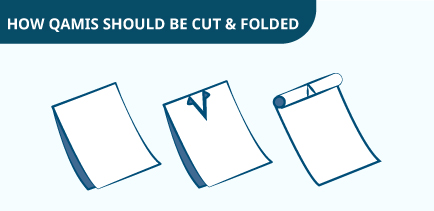
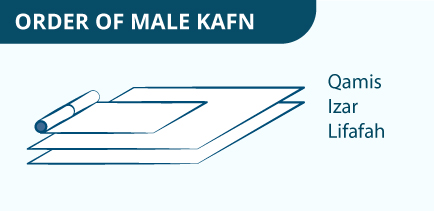
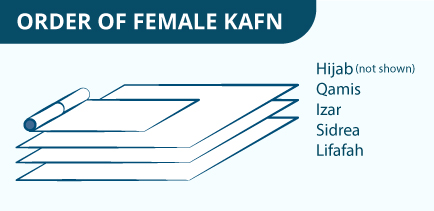
The Kafan for Males:
The Kafan of a male should consist of three white wrapping sheets and four tie ropes
- Outer sheet – Lifafah
- Second sheet – Izaar
- Third sheet – Qamees (shirt)
- 3-4 ties
- Two smaller sheets (satar) were used to cover the private parts (auwra), one before and the other after ghusl.
Steps of Shrouding:
- The wrapping sheets should be opened and spread out one on top of the other (if using one of our pre-packed kaffans, this is already done for you)
- Roll up the front half of the top sheet towards the head – Qamees (shirt)
- The deceased, covered with a sheet (satar), is lifted and laid on his back on this top sheet (Qamees)
- The Qamees is then unrolled over the front of the body and once the body is covered, then remove the satar (covering sheet)
- Some scent or perfume or sandalwood paste may be put on those parts of the body upon which one rests during prostration, that is, the forehead, nose, hands, knees, and feet.
- If it is possible, the deceased’s left hand should be placed on his chest, then put his right hand on the left hand like the way in the Salat (Prayer)
- The edge of the next sheet (Izaar) is then folded over the deceased right side, then the other edge over his left side.
- Then the last sheet (Lifafah) should be folded the same way.
- These sheets should be fastened with a piece of cloth (tie ropes), one above the head, another under the feet, and two around the body.
- This completes the shrouding for the male.
The Kafan of Females:
The Kafan of a female should consist of five white garments and four ties
- Outermost sheet – Lifafah
- Second sheet – Sinaband – to cover from under armpits to thighs
- Third sheet – Izaar
- Fourth layer – Qamees
- Last piece – Orni – to cover head and hair
- 3-4 ties
- Two smaller sheets (satar) were used to cover the private parts, one before and the other after ghusl
Steps of Shrouding:
- All the sheets should be spread out in layers (if you are using our pre-packed kaffan, this is already done as you open the kaffan)
- Roll up the front half of the top sheet towards the head – Qamees(shirt)
- The deceased, covered with a sheet (satar), is lifted and laid on her back on this top sheet (Qamees)
- The Qamees is then unrolled over the front of the body and once the body is covered, then remove the satar (covering sheet).
- Some scent or perfume may be put on those parts of the body upon which one rests during prostration, that is, the forehead, nose, hands, knees, and feet.
- The sinaband (loincloth) is bound round (acts like underwear).
- Put the head veil
- the deceased’s left hand should be placed on her chest, then put her right hand on the left hand like the way in the Salat (Prayer)
- The edge of the Izaar sheet is folded over the deceased right side, then the other edge over his left side.
- Then the last (Lifafah) sheet should be folded the same way
- These sheets should be fastened with a piece of cloth (tie ropes), one above the head, another under the feet, and two around the body.
Funeral prayer
The process for the funeral prayer is as follows:
Preparation
1. The body of deceased should be placed at the front where Imam usually stands to lead prayer.
NOTE: Most of the Luton mosques follow the Hanafi madhab which requires the presence of the body, rather than performing janazah in absence (salaatul ghaa’ib)
2. It is preferred that the deceased is turned towards direction of Qiblah.
3. The Imam should stand near the chest area of the deceased
4. There is no Adhan and no Iqamah for this janazah salaah
5. Everyone should stand facing the Qiblah direction
6. The intention should be present to pray the funeral prayer
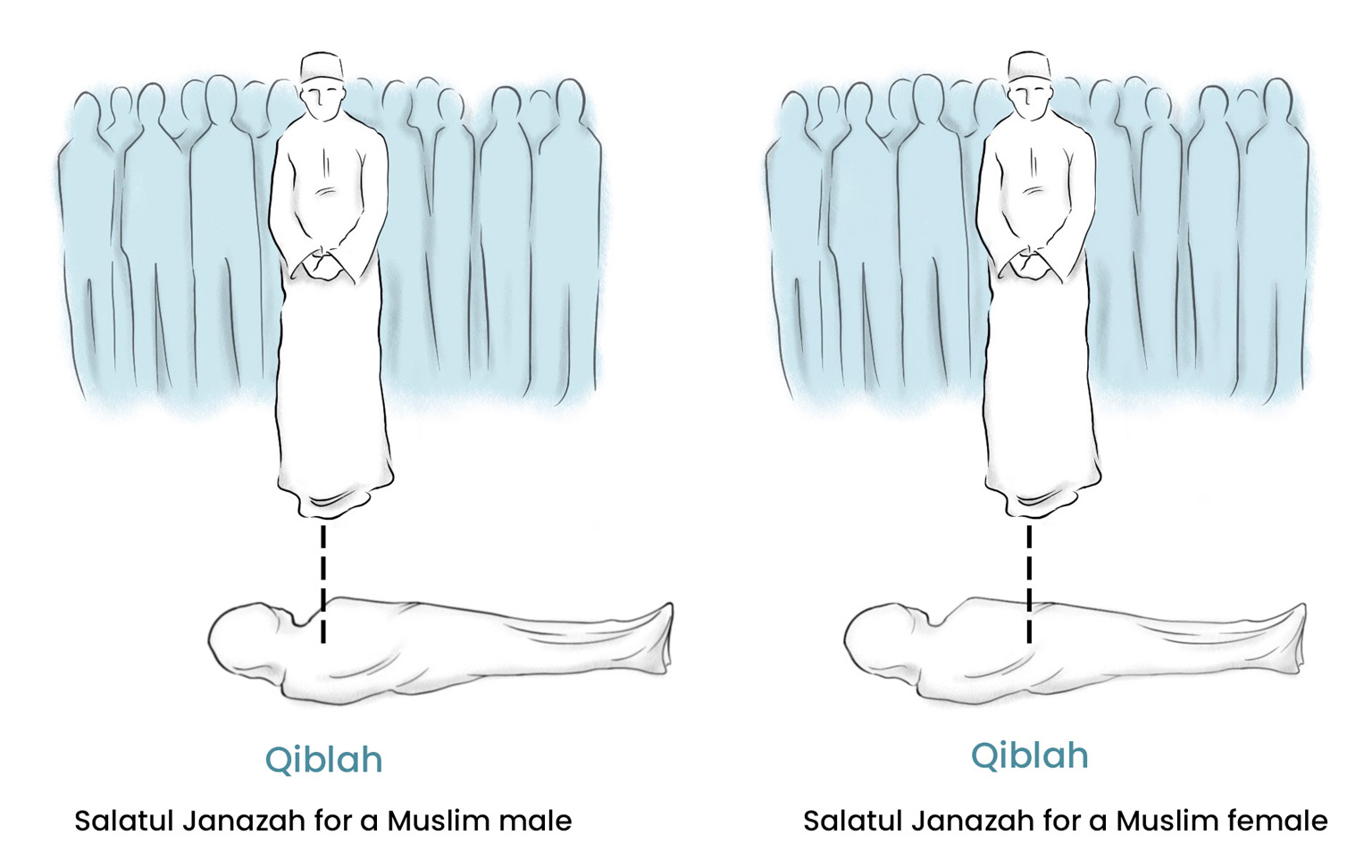
The prayer
- The Imam says Allahu Akbar aloud to begin the salaah and then folds his hands across his body placing right over left. The followers should also say Allahu Akbar silently and fold their hands in a similar manner.
- Everyone should recite quietly “Subhana kalla humma wa bihamdika, wa tabarakasmuka, wa ta’ala jadduka, wa la ilaaha ghayruk” which means “O’Allah! All glory is due to You, I praise You, your name is the Most Blessed, Your Majesty is highly exalted and there is none worthy of worship You. “In the Hanafi madhab, they only read the above as they consider this prayer to be a Dua, rather than a formal salaah (prayer). The Shafi’e, Malaki and Hanbali madhaahib state that one should read Surah Al Faatiha as well.
- The Imam will then say ‘Allahu Akbar’ for the second time. In the Hanafi Madhab there is no raising of the hands at this point unlike the other madhaahib.
- Everyone should now recite quietly the durood as follows
“Allahumma salli ‘alaa Muhammadiwa ‘alaa aali Muhammadin kamaa sallaita ‘alaa Ibrahima wa ‘alaa aali Ibrahima innaka hameedum majeed.Allahumma baarik ‘alaa Muhammadiwa ‘alaa aali Muhammadin kamaa baarakta ‘alaa Ibrahima wa ‘alaa aali Ibrahima innaka hameedum majeed.”
- This means “Oh Allah! shower Your mercy upon Muhammad and the followers of Muhammad, as You showered Your mercy upon Ibrahim and the followers of Ibrahim. Indeed, You are Praiseworthy, Glorious.
- Oh Allah! Shower Your blessing upon Muhammad and the followers of Muhammad as You showered Your blessings upon Ibrahim and the followers of Ibrahim. Indeed, You are Praiseworthy, Glorious.”
- The Imam will then say ‘Allahu Akbar’ for the third time.
- Everyone should now make dua for the deceased. One of the Prophetic Dua, which can be read here is “Allahumma-ghfir li-hayyina wa mayyitina, wa shahidina wa gha’ibina, wa sagheerina wa kabeerina, wa thakarina wa unthana. Allahumma man ahyaytahu minna fa-ahyihi ‘ala-l-islami. Wa man tawaffaytahu minna fa-tawaffahu ‘ala-l-imani. Allahumma la tahrimna ajrahu wa la taftinna ba’adahu.” meaning “O Allah, forgive our living and our dead, those present and those absent, our young and our old, our males and our females. O Allah, whom amongst us You keep alive, then let such a life be upon Islam, and whom amongst us You take unto Yourself, then let such a death be upon faith. O Allah, do not deprive us of his reward and do not let us stray after him.”
- If it is a child who has passed away, the Dua differs slightly as follows.
- For boys, it is read “Allahummaj’alhu lanaa farathaw waj’alhu lanaa ajraw wa dhukhraw waj’alhu lanaa shaafi’aw wa mushaffa’an” meaning “O Allah, make him (this child) a source for our salvation and make him a source of reward and treasure for us and make him an intercessor for us and one whose intercession is accepted.”
- For girls, it is read “Allahummaj’alhaa lanaa farathaw waj’alhaa lanaa ajraw wa dhukhraw waj’alhaa lanaa shaafi’ataw wa mushaffa’ah” meaning “O Allah, make her (this child) a source for our salvation and make her a source of reward and treasure for us and make her an intercessor for us and one whose intercession is accepted.”
- The Imam will then say ‘Allahu Akbar’ for the fourth time and then complete the prayer with salaam to the right and then left. In the Hanafi and Shafi’e madhab they do both Salam, whereas the Malaki and Hanbali schools complete with one Salam to the right only.
Method of Burial
The body will be transported to the graveyard by the appointed burial service. Arrangements will have been made with the cemetery to reserve a space in the Muslim section of the graveyard at Vale cemetery.
It is recommended when lowering the body in the grave that you say “Bismillah, wa ‘ala millati rasul-illah” meaning In the Name of Allah and according to the religion of the Messenger of Allah).
They should be placed so that it is facing the Qiblah direction. According to the Prophetic practice, this would have meant laying the deceased on their side in the grave. If there is a requirement to keep the coffin, the head of the coffin should face towards the Qiblah.
Then, the remainder of the grave should be filled with the earth removed from the grave. Care should be taken not to step, disturb or take earth from other graves. Earth should not go directly on to the body and it’s recommended to contribute at least three handfuls to the burial while reading from Surah Taha as follows “Minha khalaqnaakum wafeehaa nu’eedukum wa minha nukhrijukum taaratan ukhraa” meaning “From the earth We created you, and into it We will return you, and from it We will extract you another time.
The remaining earth can be filled in using the digger. According to the Sunnah, the grave should be slightly raised above the ground with a prominent mound over it in order for it to be recognized as a grave. Sufyan at-Tammaar (RA) said that he had seen the grave of the Prophet (sallallaahu `alayhi wa sallam) and that it was humped. [Al-Bukhari]
At the time of Prophet Muhammad (peace and blessings be upon him) no headstone was used, although some scholars permit the use of a very simple headstone for identification purposes only. The information on it can include grave number, name of the deceased, date of death and age. No Qur’anic verse or scriptures should be used as its primary purpose is only as a way to locate loved ones.
Visiting & maintaining the grave
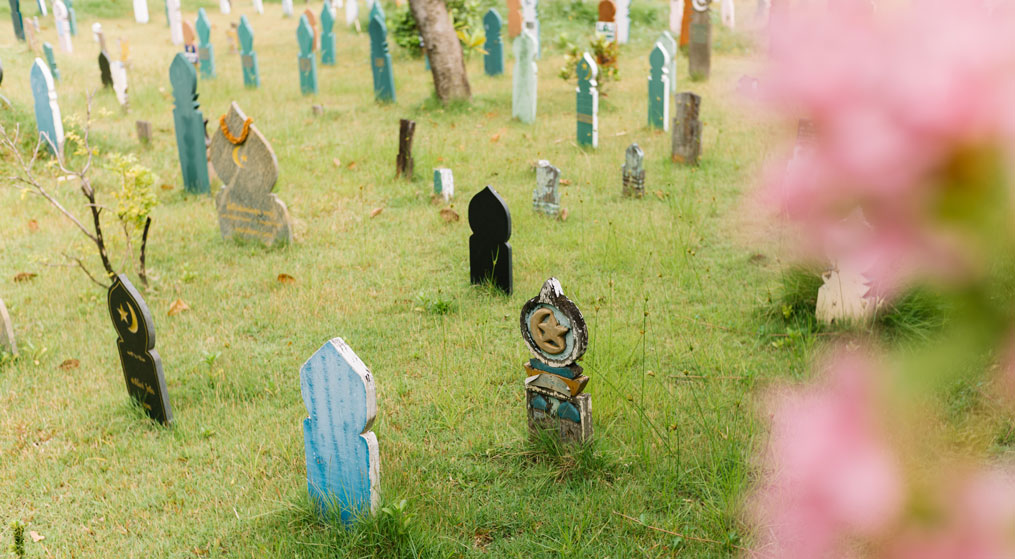
The Prophet Muhammad (SAW) said “Visit the grave as often as possible, it will soften hearts and remind you of death.”
The purpose of visiting the graves is to remind us about our inevitable end and return to Allah (SWT) to account for our lives.
On entering the graveyard, its recommended to say Assalaamu ‘alaykum ahl al-diyaar min al-mu’mineen wa’l-Muslimeen, in sha Allaah bikum laahiqoon, as’al Allaaha lana wa lakum al-‘aafiyah which means “Peace be upon you O people of the dwellings, believers and Muslims, InshaAllah we will join you; I ask Allah to keep us and you safe and sound).”
When visiting the graveyard, it’s important to make Dua (supplication) for the deceased and not to talk about worldly matters. Dua should be made facing the qibla, not the graves. Care should be taken not to walk on or disturb any of the graves.
For those who have passed away, it’s important to remember them in a good light and if one is not able to, then it’s better to remain silent.
Special Cases
1) Miscarried Fetus:
The general principle regarding stillborns, if is the fetus was dead in the uterus or was not alive at the time of birth then there is no ghusl or salatul Janazah.
Other opinions:
If the fetus is less than four months old (Mother was pregnant for less than four months), then the fetus may not be washed; the fetus should be wrapped in a piece of white cloth and buried. Then there is no Salatul Janazah for this fetus.
If the fetus is more than four months old (Mother was pregnant for more than four months), then the fetus may be washed, shrouded (Using one or two winding sheets to cover the whole body), and then Muslims have the choice whether to perform Salatul Janazah or not.
2) Children:
A) Before reaching the age of puberty, a child may be washed by males or females. Shrouding a child for females use a shirt and two winding sheets and for males two or three winding sheets may be used.
B) For those children who reached the age of puberty, they should be dealt with as an adult {Female childlike female adult, and male childlike male adult}, but then Salatul Janazah be performed.
3) Martyr:
The body of a Martyr should not be washed, nor be shrouded but buried with the same clothes that people found him with.
The strongest opinion of Muslim scholars is not to offer Salatul Janazah for martyrs since Prophet Muhammad (P.B.U.H) did not offer it for the martyrs of the battle of Uhud.
The Edda (waiting period) of Muslim widows (females)
Edda is prescribed for widows in order to mourn the death of their husbands, observe their memory, fulfill any obligations toward them, and to see if the widow is pregnant or not.
Um Atiyyah reported that the Messenger of Allah said: “A woman should not mourn for any deceased person for more than three days, except in the case of her husband’s death, which she may mourn for a period of four months and ten days. Such a woman in mourning is not to wear any fancy, bright clothes, but only plain clothes, not use any adornment or make-up, nor use perfume, nor die her hands or feet with Henna ” (Bukhari & Muslim).
If the widow is pregnant, then her waiting period ends when she delivers her baby, according to Allah’s command in the Quran: ” And for those who are pregnant, their Edda is until they deliver ” (Quran 65:4).
Duration of Edda
Pregnant- Until Delivery
Not pregnant – Four Months and Ten Days
So, a widow during the Edda should:
- Live and sleep in her home, and only leave when it is necessary
- She should not wear fancy bright clothes, not wear jewelry, not use makeup including eyeliners (kohl), not use perfume.
This is not a time to deprive herself from lawful things or to suffer unduly. It is a time to remember the memories of her husband, make Dua for him, think about herself and plan for the future.